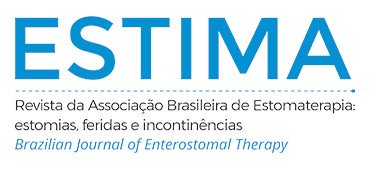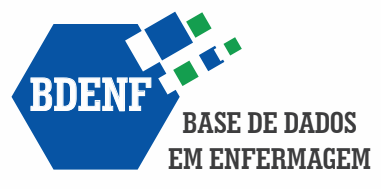EDUCATIONAL INTERVENTION ON INCONTINENCE-ASSOCIATED DERMATITIS: TEACHING STRATEGY ON INSTAGRAM
Abstract
Objectives: To describe and evaluate, in a formative way, an educational intervention carried out through social media on incontinence-associated dermatitis with nursing professionals from a public hospital. Method: Educational intervention study with a qualitative approach conducted in a virtual way through the social media Instagram as a platform for the dissemination of course content on the subject. Data collection was carried out with 30 nursing professionals from the medical clinic and adult intensive care unit of a public teaching hospital in the state of Mato Grosso do Sul, Brazil, between February and March 2022. Data were collected during the course and analysed through content analysis and according to Ausubel’s meaningful learning theoretical framework perspective. Results: From the analysis of the participants’ comments, four thematic categories emerged: anchoring; subordinated meaningful learning; discovery learning; and evaluation of the teaching- learning process. Conclusion: Through the results found, it was identified that the educational intervention conducted was successful in terms of sharing evidence on the subject to the participants. It was found that the Instagram can be adopted as a tool to carry out educational actions, including in a hospital environment.
Downloads
Metrics
References
Fletcher J, Beeckman D, Boyles A, Fumarola S, Kottner J, Mcnichol L, et al. International best practice recommendations: prevention and management of moisture associated skin damage (MASD). Wounds Int [Internet]. 2020 [acessado em 20 mar. 2022];1-20. Available at: https://www.woundsinternational.com/resources/details/best-practice-recommendations-
prevention-and-management-moisture-associated-skin-damage-masd
Gray M, Giuliano KK. Incontinence-associated dermatitis, characteristics and relationship to pressure injury: a multisite epidemiologic analysis. J. Wound Ostomy Continence Nurs 2018;45(1):63-7. https://doi.org/10.1097/WON.0000000000000390
Kayser SA, Koloms K, Murray A, Khawar W, Gray M. Incontinence and incontinence-associated dermatitis in acute care: a retrospective analysis of total cost of care and patient outcomes from the Premier Healthcare Database. J. Wound Ostomy Continence Nurs. 2021;48(6):545-52. https://doi.org/10.1097/WON.0000000000000818
National Pressure Ulcer Advisory Panel, European Pressure Ulcer Advisory Panel, Pan Pacific Pressure Injury Aliance. Prevention and treatment of pressure ulcers: quick reference guide [Internet]. Cambridge Media: Osborne Park; 2019 [acessado em 5 fev.2022]. Available at: https://www.epuap.org/download/11182/
Veiga GA, Araújo MC, Cauduro FLF, Andrade J. Metodologia ativa no estágio supervisionado de enfermagem: inovação na atenção primária à saúde. Rev Baiana Enferm 2020;34:e34857. https://doi.org/10.18471/rbe.v34.34857
Lovato FL, Michelotti A, Loreto ELS. Metodologias ativas de aprendizagem: uma breve revisão. Acta Scientiae 2018;20(2):154- 71. https://doi.org/10.17648/acta.scientiae.v20iss2id3690
Agra G, Formiga NS, Oliveira PS, Costa MML, Fernandes MGM, Nóbrega MML. Analysis of the concept of Meaningful Learning in light of the Ausubel’s Theory. Rev Bras Enferm 2019;72(1):248-55. https://doi.org/10.1590/0034-7167-2017-0691
Haiashida KA, Maia RHC. Educação permanente em saúde: revisão integrativa. Itinerarius Reflectionis 2018;14(4):1-25. https://doi.org/10.5216/rir.v14i4.55163
Danski MTR, Oliveira GLR, Pedrolo E, Lind J, Johann DA. Importância da prática baseada em evidências nos processos de trabalho do enfermeiro. Ciên Cuidado Saúde 2017;16(2):1-6. https://doi.org/10.4025/ciencuidsaude.v16i2.36304
Brasil. Ministério da Saúde. Portaria no 198, de 13 de fevereiro de 2004. Institui a Política Nacional de Educação Permanente em Saúde como estratégia do Sistema Único de Saúde para a formação e o desenvolvimento de trabalhadores para o setor. Brasília: Ministério da Saúde; 2004.
Adamy EK, Zocche DAA, Vendruscolo C, Metelski FK, Argenta C, Valentini JS. Tecendo a educação permanente em saúde no contexto hospitalar: relato de experiência. Rev Enferm Centro-Oeste Mineiro 2018;8:e1924. https://doi.org/10.19175/recom.v8i0.1924
Fernandes CSNN, Ângelo M, Estratégias lúdicas utilizadas em enfermagem: uma revisão integrativa. Avances Enferm 2018;36(1):88-98. https://doi.org/10.15446/av.enferm.v36n1.63553
Sotero AM, Ribeiro LO, Menezes MS, Coelho NMR, Bento Junior PCT, Gama TCCL, et al. O uso do Instagram como estratégia de promoção à saúde do PET Saúde/Interprofissionalidade. Rev Extensão UPE 2021; 6(1): 3-11. https://doi.org/10.56148/2675-2328reupe.v6n1.199.pp3-11
Latif MZ, Hussain I, Saeed R, Qureshi MA, Maqsood U. Use of smart phones and social media in medical education: trends, advantages, challenges and barriers. Acta Inform Med 2019;27(2):133-8. https://doi.org/10.5455/aim.2019.27.133-138
Pather P, Hines S, Kynoch K, Coyer F. Effectiveness of topical skin products in the treatment and prevention of incontinence associated dermatitis: a systematic review. JBI Database Syst Rev Implement Rep 2017;15(5):1473-96. https://doi.org/10.11124/jbisrir-2016-003015
Ousey K, O’Connor L, Doughty D, Hill R, Woo K. Incontinence-associated dermatitis Made Easy. Wounds Int [Internet] 2017 [acessado em 30 mar. 2022];8(2). Available at: https://www.woundsinternational.com/resources/details/iad-made-easy
Raepsaet C, Fourie A, Van Hecke A, Verhaeghe S, Beeckman D. Management of incontinence-associated dermatitis: A systematic review of monetary data. Int Wound J 2021;18(1):79-94. https://doi.org/10.1111/iwj.13496
Brandão ACMAG, Gambin CC, Majado CA, Kunitake N, Alexandre NMC, Dantas SRPE. Adaptação do instrumento “Perineal Assessment Tool” para a cultura brasileira. ESTIMA, Braz J Enterostomal Ther 2018;16:e0618. https://doi.org/10.30886/estima.v16.397_PT
Gomes DF, Moita MP, Oliveira LC, Dias MSA. Avaliação formativa em saúde: uma análise das evidências latino-americanas. Revista Saúde 2021;47(1):1-14. https://doi.org/10.5902/2236583465079
Bardin L. Análise de Conteúdo. Lisboa: Edições 70; 2016.
Woo KY, Beeckman, Dimitri D, Chakravarthy D. Management of moisture-associated skin damage: a scoping review. Adv Skin Wound Care 2017;30(11):494-501. https://doi.org/10.1097/01.ASW.0000525627.54569.da
Beeson T, Eifrid B, Pike CA, Pittman J. Do intra-anal bowel management devices reduce incontinence-associated dermatitis and/or pressure injuries? J Wound Ostomy Contin Nurs 2017;44(6):583-88. https://doi.org/10.1097/WON.0000000000000381
Wilson MM, Angyus M, Beals D, Callan L, Francis K, Kingan M, et al. Executive summary: a quick reference guide for managing fecal incontinence (FI). J Wound Ostomy Contin Nurs 2014;41(1):61-9. https://doi.org/10.1097/WON.0000000000000004
Brasil. Ministério da Saúde. Agência Nacional de Vigilância Sanitária. Nota técnica GVIMS/GGTES no 03/2017: práticas seguras para prevenção de lesão por pressão em serviços de saúde [Internet]. Brasília: Ministério da Saúde; 2017 [acessdo em 8 mar.2022]. Available at: https://www.gov.br/anvisa/pt-br/centraisdeconteudo/publicacoes/servicosdesaude/notas-tecnicas/nota-
tecnica-gvims-ggtes-no-03-2017.pdf
Ceccim RB. Emergência de um “campo de ação estratégica”: ordenamento da formação e educação permanente em saúde. Sanare 2019;18(1):68-80. https://doi.org/10.36925/sanare.v18i1.1307
Downloads
Published
How to Cite
Issue
Section
License
Copyright (c) 2022 Jaqueline Aparecida dos Santos Sokem, Adriano Menis Ferreira, Fabiana Perez Rodrigues Bergamaschi, Manuela de Mendonça Figueirêdo Coelho, Caroline Neris Ferreira Sarat, Edilma Batista Rodrigues Ribeiro, Caroline Cordeiro Souto, Liliane Moretti Carneiro, Marcelo Alessandro Rigotti

This work is licensed under a Creative Commons Attribution 4.0 International License.

























